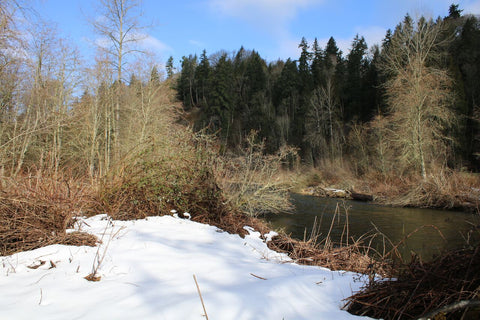
Snow Problem | 200 Native Plants in the Frozen Ground
After the snowiest February in Seattle history we were expecting the ground to be a little frozen when we went to dig our shovels in at Ron Regis park for the first time this year. What we didn't foresee was a couple inches of snow still on the ground when we got to the Cedar River.

It was a cold, beautiful morning and the volunteer turnout with Forterra NW was incredible. This was ET's third event at Ron Regis so far and each time the group has gotten a little bigger. Cold temperatures didn't discourage anyone. This time there were over 20 people involved, and we teamed up to plant 200 Indian Plum, hardhack, Salmon Berry and Oregon Ash. These native plants play an integral role in building the health of this ecosystem.

Last year we spent most of our time at the park clearing invasive species and planting Doug Fir, Cedar and Sitka Spruce all over the forest. After such a long and dry summer and a harsh winter, it was really encouraging to see most of the young treez thriving in their first year.

The start of the planting party came with a little frustration as Alex with Forterra told us that the supply van got stuck in some deep snow. Luckily we were able to get it out and we started unloading the tools over coffee and donuts.

Alex and Maya explained to the volunteers what the game plan for planting in the snow would be. The four species we had were all bare root plants. That means that they come rolled in strands with long, spaghetti like roots. The key to helping them establish roots at a young age is to make sure the roots are spread out and untangled. You want the holes to be about 6 inches deep, with the bottom of the roots just brushing the bottom of the hole.

Before digging in, the first task was to tag the plants with red tape so we can track their progress and so people don't mistake them as invasive species. Once the plants were tagged we split into task forces and dispersed throughout the planting area. Once we started digging we realized that the ground was a lot softer than anticipated. The snow was easy to dig into and the soil below was incredibly soft.

We bought a drone back in July so that we could capture aerial shots of planting sights and birds eye views of the forest. We were hyped to take it up on such a beautiful morning. Unfortunately a rouge gust of wind took it into the treez and we had our first aerial camera crash. Luckily no one was in the flight path when she came crashing down. We'll definitely put the footage into a future edit because it's pretty damn entertaining. With that excitement out of the way we kept digging like Stanley Yelnats and before we knew it there were 200 new native plants in the ground.

It's now been almost a year since we fortuitously met the passionate and inspiring Forterra NW crew during our rogue planting at Ron Regis park. Since last May we've made great strides to improve the health of this riparian forest along the banks of the Cedar River. Considering the fact that we've been coming here to swim, disconnect and enjoy nature for over a decade now, it feels great to give back. The Cedar River watershed is an important resource that we need to protect in order to ensure a healthy spawning ground for native salmon. Our work here is on-going; you can join us at our next planting party on May 18th! Hopefully there won't be any snow on the ground by then. You can RSVP at forterra.org/events

